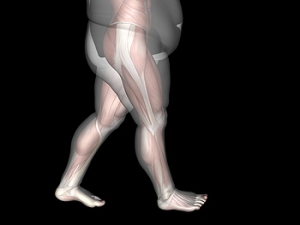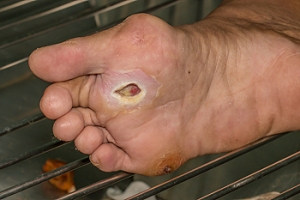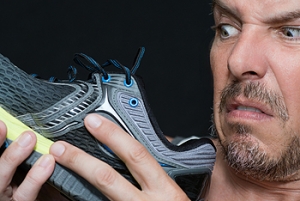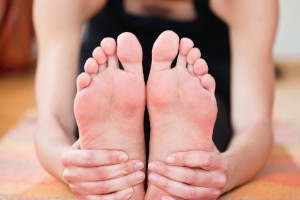Connect With Us
Featured Articles
Super User
How to Treat Heel Spurs
Heel spurs are calcium deposits that cause bone protrusions on the heel bone. Heel spurs are usually associated with plantar fasciitis, which occurs when the plantar fasciitis in the foot becomes inflamed. Typically, heel spurs don’t cause any symptoms. However, they can produce chronic or intermittent heel pain. Those who have had the condition often describe the irritation as a stabbing pain.
There are risk factors that may make you more likely to develop heel spurs. People who have abnormal walking gaits, run and jog on hard surfaces, are obese, or wear poorly fitting shoes are more likely to develop heel spurs.
Fortunately, there are precautions you can take to avoid developing heel spurs. One of the best ways to do this is by wearing well-fitting shoes with shock-absorbent soles. Another preventative technique is to choose running shoes if you plan on running, and walking shoes if you plan on walking. Shoes are made for different activities and it is important to research a shoe before you purchase a pair.
The pain associated with heel spurs often decreases the more you walk. However, a recurrence of pain after an extended period of rest or walking is likely to occur with this condition. Those with severe heel spur pain may opt to go the surgical route for treatment. However, more than 90% of those with the condition get better without surgical treatment. If you have a heel spur and want to know if surgery is right for you, you should go to your podiatrist and he or she will be able to conduct a pre-surgical test or exam to determine if you are an optimal candidate for surgery.
Heel Pain May Be Common Among Overweight Patients
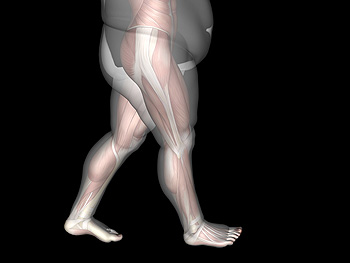 Obesity affects a large percentage of people worldwide. The additional weight the feet endure can lead to the development of painful foot conditions. Heel pain is a common ailment, and it can be indicative of specific foot complications. These can include plantar fasciitis, flat feet, or different types of arthritis. Many people who are overweight are faced with the dilemma of lacking the desire to exercise. Performing frequent stretches and exercises is beneficial to losing weight, despite that it may be difficult to accomplish. If you have gained weight and have frequent heel pain, it is recommended that you are under the care of a podiatrist who can properly diagnose you and help to manage your weight.
Obesity affects a large percentage of people worldwide. The additional weight the feet endure can lead to the development of painful foot conditions. Heel pain is a common ailment, and it can be indicative of specific foot complications. These can include plantar fasciitis, flat feet, or different types of arthritis. Many people who are overweight are faced with the dilemma of lacking the desire to exercise. Performing frequent stretches and exercises is beneficial to losing weight, despite that it may be difficult to accomplish. If you have gained weight and have frequent heel pain, it is recommended that you are under the care of a podiatrist who can properly diagnose you and help to manage your weight.
The more you weigh, the harder your feet must work to support your body. If you’re an obese individual and are concerned about your feet, contact Dr. Howard Horowitz from Bowie Foot & Ankle . Our doctor can provide the care you need to keep you pain-free and on your feet.
Obesity and Your Feet
People who are overweight are putting more pressure on their ankles, knees, and hips as well as their feet. This unfortunately can lead to variety of different issues.
Problems & Complications Stemming from Obesity
- When the body is overweight, it tries to compensate by changing the way that it moves. An obese person may lean forward and put extra weight on the wrong part of the foot. This puts unnecessary stress on the feet.
- Obese people are also more likely to develop type II diabetes which is a condition that causes a lot of foot problems. People with diabetes often don’t feel the cuts and sores that they may have on their feet, which can lead to more complicated and severe issues.
- Plantar fasciitis is another foot condition that can be caused by obesity. Plantar fasciitis is an inflammation of the tissue along the bottom of the foot, which causes pain and stiffness while walking and climbing stairs.
If you have any questions, please feel free to contact our office located in Bowie, MD. We offer the newest diagnostic and treatment technologies for all your foot care needs.
Read more about Obesity and the FeetObesity and the Feet
Obesity is a common problem in American society. Approximately one third of the U.S. population is obese. Obesity is defined as a body mass index greater than 30. Obesity has the power to affect different aspects of the body, and one of the most common problems it causes is foot pain. There have been many studies that found a connection between an increased BMI and foot problems. A simple activity such as walking up a flight of stairs can increase pressure on the ankle by four to six times.
Being overweight causes the body to compensate for the extra weight by changing the way it moves. Consequently, people who struggle with obesity commonly have arch problems in their feet. Obesity causes the arch to break by stretching the ligaments and tendons that hold the bones in the foot together. When the arch lowers, the foot may eventually fall flat. Collapsed foot arches fail to provide adequate shock absorption which eventually leads to foot pain. Other conditions that may be caused by flat feet are pronation, plantar fasciitis, weak ankles, and shin splints.
Foot problems that are caused by obesity may be treated by wearing proper footwear. Proper shoes will allow your feet to have better circulation around the arch and ankle. Additionally, those with obesity often discover that typical heel pain remedies are not effective for them. They will find that their plantar fascia is easily injured, and it is often inflamed. The best way to treat this problem is to implement lifestyle changes. A few good ways to improve your diet are to reduce calories, fill up on fruits and veggies, and to limit sugars.
Custom foot orthotics can prevent foot problems if you’re carrying excess weight or are trying to lose weight. The purpose of orthotics is to provide shock absorption to decrease the amount of stress on the joints to prevent arthritis.
What Contributes to the Development of a Wound?
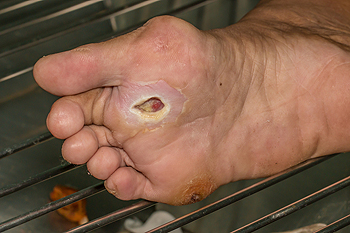 It’s very common for wounds to form on the feet, especially for someone who has diabetes. One of the most common foot conditions that form, due to diabetes, is called an ulcer. Foot ulcers are open sores that can be very deep, and in severe cases, may require amputation if left untreated. Treating diabetic wounds can be difficult if a diabetic patient is also afflicted with peripheral neuropathy. This condition causes a lack of feeling in the feet. If a wound goes unnoticed or untreated, there is a strong likelihood that it will become infected. There are a number of different risk factors that can lead to the development of a diabetic wound, including a structural defect, and poor diabetes control. If you have developed a wound on your feet, it is highly recommended that you consult with a podiatrist who can help treat this condition.
It’s very common for wounds to form on the feet, especially for someone who has diabetes. One of the most common foot conditions that form, due to diabetes, is called an ulcer. Foot ulcers are open sores that can be very deep, and in severe cases, may require amputation if left untreated. Treating diabetic wounds can be difficult if a diabetic patient is also afflicted with peripheral neuropathy. This condition causes a lack of feeling in the feet. If a wound goes unnoticed or untreated, there is a strong likelihood that it will become infected. There are a number of different risk factors that can lead to the development of a diabetic wound, including a structural defect, and poor diabetes control. If you have developed a wound on your feet, it is highly recommended that you consult with a podiatrist who can help treat this condition.
Wound care is an important part in dealing with diabetes. If you have diabetes and a foot wound or would like more information about wound care for diabetics, consult with Dr. Howard Horowitz from Bowie Foot & Ankle . Our doctor will assess your condition and provide you with quality foot and ankle treatment.
What Is Wound Care?
Wound care is the practice of taking proper care of a wound. This can range from the smallest to the largest of wounds. While everyone can benefit from proper wound care, it is much more important for diabetics. Diabetics often suffer from poor blood circulation which causes wounds to heal much slower than they would in a non-diabetic.
What Is the Importance of Wound Care?
While it may not seem apparent with small ulcers on the foot, for diabetics, any size ulcer can become infected. Diabetics often also suffer from neuropathy, or nerve loss. This means they might not even feel when they have an ulcer on their foot. If the wound becomes severely infected, amputation may be necessary. Therefore, it is of the upmost importance to properly care for any and all foot wounds.
How to Care for Wounds
The best way to care for foot wounds is to prevent them. For diabetics, this means daily inspections of the feet for any signs of abnormalities or ulcers. It is also recommended to see a podiatrist several times a year for a foot inspection. If you do have an ulcer, run the wound under water to clear dirt from the wound; then apply antibiotic ointment to the wound and cover with a bandage. Bandages should be changed daily and keeping pressure off the wound is smart. It is advised to see a podiatrist, who can keep an eye on it.
If you have any questions, please feel free to contact our office located in Bowie, MD. We offer the newest diagnostic and treatment technologies for all your foot care needs.
Read more about Wound CareWound Care
Diabetics must be wary of all wounds, regardless of depth or size. Diabetes, a chronic disease in which the body cannot properly use glucose the way it normally would, causes various complications that make wounds difficult to heal. Nerve damage or neuropathy will cause diabetics to have trouble feeling the pain of a blister or cut until the condition has significantly worsened or become infected. A diabetic’s weakened immune system can make even the most minor of wounds easily susceptible to infection. Diabetics are also more prone to developing narrow, clogged arteries, and are therefore more likely to develop wounds.
Wounds should be taken care of immediately after discovery, as even the smallest of wounds can become infected if enough bacteria build up within the wound. To remove dirt, wounds should be first rinsed under running water only. Soap, hydrogen peroxide, or iodine can irritate the injury and should be avoided. To prevent infection, apply antibiotic ointment to the wound and cover it with a bandage. The bandage should be changed daily. The skin around the wound may be cleaned with soap.
To prevent further exacerbation, see a doctor—especially if you have diabetes. Minor skin conditions can become larger problems if not properly inspected. As the wound heals, make sure to avoid applying pressure to the affected area.
Excessively Sweaty Feet
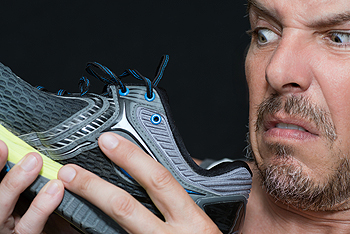 If you have noticed that your feet sweat excessively, even if you have not participated in any high energy physical activity, you may be experiencing symptoms of a foot condition known as hyperhidrosis. This condition causes the sweat glands to be more active than normal, producing a large amount of sweat, which can in turn, also create an unpleasant odor. Hyperhidrosis can also lead to the development of other foot conditions such as athlete’s foot or a fungal toenail infection. This condition may develop at any age, and is commonly brought about due to hereditary reasons. Washing and drying the feet regularly, wearing breathable footwear and socks, as well as using antifungal powders, may help ease the discomfort of this condition. For more advice on how to properly treat hyperhidrosis, it is recommended that you consult with a podiatrist.
If you have noticed that your feet sweat excessively, even if you have not participated in any high energy physical activity, you may be experiencing symptoms of a foot condition known as hyperhidrosis. This condition causes the sweat glands to be more active than normal, producing a large amount of sweat, which can in turn, also create an unpleasant odor. Hyperhidrosis can also lead to the development of other foot conditions such as athlete’s foot or a fungal toenail infection. This condition may develop at any age, and is commonly brought about due to hereditary reasons. Washing and drying the feet regularly, wearing breathable footwear and socks, as well as using antifungal powders, may help ease the discomfort of this condition. For more advice on how to properly treat hyperhidrosis, it is recommended that you consult with a podiatrist.
If you are suffering from hyperhidrosis contact Dr. Howard Horowitz of Bowie Foot & Ankle . Our doctor can provide the care you need to attend to all of your foot and ankle needs.
Hyperhidrosis of the Feet
Hyperhidrosis is a rare disorder that can cause people to have excessive sweating of their feet. This can usually occur all on its own without rigorous activity involved. People who suffer from hyperhidrosis may also experience sweaty palms.
Although it is said that sweating is a healthy process meant to cool down the body temperature and to maintain a proper internal temperature, hyperhidrosis may prove to be a huge hindrance on a person’s everyday life.
Plantar hyperhidrosis is considered to be the main form of hyperhidrosis. Secondary hyperhidrosis can refer to sweating that occurs in areas other than the feet or hands and armpits. Often this may be a sign of it being related to another medical condition such as menopause, hyperthyroidism and even Parkinson’s disease.
In order to alleviate this condition, it is important to see your doctor so that they may prescribe the necessary medications so that you can begin to live a normal life again. If this is left untreated, it is said that it will persist throughout an individual’s life.
A last resort approach would be surgery, but it is best to speak with your doctor to find out what may be the best treatment for you.
If you have any questions please feel free to contact our office located in Bowie, MD. We offer the newest diagnostic and treatment technologies for all your foot and ankle needs.
Read more about Hyperhidrosis of the FeetHyperhidrosis of the Feet
Each foot, on average, has about 250,000 eccrine sweat glands that produce half a pint of sweat each day. Sweating is a natural and important bodily function. It regulates the body’s temperature by cooling the skin so that it does not overheat. In individuals with hyperhidrosis, the sympathetic nervous system works in "overdrive", producing far more sweat than what is required. People with plantar hyperhidrosis experience an excess amount of sweat on their feet. It is estimated that 2% to 3% of all Americans suffer from some form of hyperhidrosis. This condition is often caused by neurologic, endocrine, infectious, and other systemic disease. Other factors that may trigger the condition are heat and emotions.
People with hyperhidrosis may notice an overabundance of sweat on their feet, along with a strong odor. The feet may also have a wet appearance coupled with infections such as athlete’s foot or toenail fungus. The sweat may even appear in low temperatures, such as during the winter months. People with plantar hyperhidrosis often need to change their socks several times throughout the day.
The specific cause of hyperhidrosis is unknown, and many believe it may be caused by over-activity. However, others believe the condition is genetic. Caffeine and nicotine are known to cause excitement and nervousness which are two emotions that may make the condition worse.
If you are looking to treat your hyperhidrosis the most important thing you should do is wash your feet every day. You may even need to wash your feet twice a day, if necessary. You should also make sure you are wearing the right socks. Wool and cotton socks are both known to be good for ventilation, meaning they allow the feet to breathe. You should avoid socks made from nylon which trap moisture and lead to sogginess. Other common treatment options are over-the-counter antiperspirants that contain a low dose of metal salt. In some cases, prescription strength antiperspirants that contain aluminum chloride hexahydrate may be necessary. In severe cases, surgery may be required.
Untreated hyperhidrosis can easily lead to complications. Some complications that may arise from the disorder include nail infections, warts, and bacterial infections. Consequently, it is important that you seek treatment from your podiatrist if you suspect that you may have plantar hyperhidrosis.
How Stretching Can Relieve Foot Pain
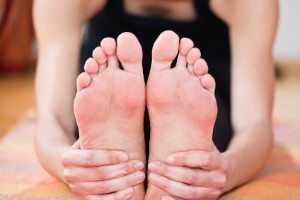 Foot pain can be uncomfortable and make completing every day tasks harder. It can also impact how you walk and limit your mobility. To help alleviate foot pain, it may be beneficial to regularly practice certain stretches designed for strengthening the feet, as well as helping to keep the feet flexible and less tense. There are a number of different stretches you can perform that may benefit certain areas of your lower extremities. For example, one stretch you can perform helps to build your plantar fascia and calf muscles. To complete this stretch, stand on a step, and while holding onto a banister, begin to lower your heel over the edge of the step until you feel the stretch, then hold that position for 15-30 seconds. Then you can slowly bring your heel up, and switch to the other foot and repeat that same action. Another stretch you can practice may benefit your toes, as well as the rest of your foot. Sit on the floor with your legs straight out, then wrap a towel underneath your toes. Grab each end of the towel and begin to pull the towel toward you. Again, you may hold this position for 15-30 seconds. For more information on how different stretches can benefit your feet, it’s suggested that you contact a podiatrist for professional advice.
Foot pain can be uncomfortable and make completing every day tasks harder. It can also impact how you walk and limit your mobility. To help alleviate foot pain, it may be beneficial to regularly practice certain stretches designed for strengthening the feet, as well as helping to keep the feet flexible and less tense. There are a number of different stretches you can perform that may benefit certain areas of your lower extremities. For example, one stretch you can perform helps to build your plantar fascia and calf muscles. To complete this stretch, stand on a step, and while holding onto a banister, begin to lower your heel over the edge of the step until you feel the stretch, then hold that position for 15-30 seconds. Then you can slowly bring your heel up, and switch to the other foot and repeat that same action. Another stretch you can practice may benefit your toes, as well as the rest of your foot. Sit on the floor with your legs straight out, then wrap a towel underneath your toes. Grab each end of the towel and begin to pull the towel toward you. Again, you may hold this position for 15-30 seconds. For more information on how different stretches can benefit your feet, it’s suggested that you contact a podiatrist for professional advice.
Stretching the feet is a great way to prevent injuries. If you have any concerns with your feet consult with Dr. Howard Horowitz from Bowie Foot & Ankle . Our doctor will assess your condition and provide you with quality foot and ankle treatment.
Stretching the Feet
Stretching the muscles in the foot is an important part in any physical activity. Feet that are tight can lead to less flexibility and make you more prone to injury. One of the most common forms of foot pain, plantar fasciitis, can be stretched out to help ease the pain. Stretching can not only ease pain from plantar fasciitis but also prevent it as well. However, it is important to see a podiatrist first if stretching is right for you. Podiatrists can also recommend other ways to stretch your feet. Once you know whether stretching is right for you, here are some excellent stretches you can do.
- Using a foam roller or any cylindrical object (a water bottle or soda can will do), roll the object under your foot back and forth. You should also exert pressure on the object. Be sure to do this to both feet for a minute. Do this exercise three times each.
- Similar to the previous one, take a ball, such as a tennis ball, and roll it under your foot while seated and exert pressure on it.
- Grab a resistance band or towel and take a seat. If you are using a towel, fold it length wise. Next put either one between the ball of your foot and heel and pull with both hands on each side towards you. Hold this for 15 seconds and then switch feet. Do this three times for each foot.
- Finally hold your big toe while crossing one leg over the other. Pull the toe towards you and hold for 15 seconds. Once again do this three times per foot.
It is best to go easy when first stretching your foot and work your way up. If your foot starts hurting, stop exercising and ice and rest the foot. It is advised to then see a podiatrist for help.
If you have any questions, please feel free to contact our office located in Bowie, MD. We offer the newest diagnostic and treatment technologies for all your foot care needs.
Read more about Stretching Your FeetStretching Your Feet
Debilitating foot pain is a problem for many people. But just as stretching the torso can help alleviate back pain, stretching the feet can also help mend existing foot problems and prevent future ones.
The feet, as the body’s foundation, carry the body’s entire weight and can get easily strained from overexertion. Persistent sharp pain and cramping in the feet are often common concerns. Foot pain and foot problems can be due to any number of causes, and in many cases pain may be eased without medication or doctor visits. It is always a good idea, however, to first rule out any serious medical issues with a physician.
Stretching can help relax the feet and alleviate pain, but is especially important before heavy aerobic exercise. Stretching before such activities can help you avoid experiencing painful cramps or strained foot muscles. Stretches should be performed slowly and deliberately without forceful pulling. The stretch should be held for several seconds before relaxing.
A great way to stretch out and loosen up the foot muscles while sitting is to cross one leg over the other and pull the toes carefully back without overextending. Start by resting the left ankle on the right knee. With the left hand, gently flex the left foot by pulling back on the toes. Do not pull too hard; just hard enough to feel the stretch in the arch of the foot. Then point the toes of the left foot as far as you can. Rotate the motion of pointing with pulling back on the toes. This should relax and stretch the muscles on the bottom and the top of the foot. Doing this stretch ten to twenty times should bring relief. Repeat the whole process for the other foot by resting the right ankle on the left knee.
A stretch that focuses on the often injured Achilles tendon involves standing and facing a wall with your arms out and hands flat against the wall. Step back with one foot, keeping it flat against the floor. Move the other leg forward and lean toward the wall. You should feel a stretch through the back of your leg and your Achilles tendon, but do not push yourself too much. Stop when you feel a stretching sensation, and hold for 30 seconds. Ten repetitions may be done for each foot.
Stretching the feet is important for athletes or those performing aerobic exercise, but it can also help anyone with foot pain caused by poor footwear, plantar fasciitis, or long hours standing and walking. Individuals who tend to their feet by regularly stretching every day should be able to minimize foot pain and prevent new problems from arising.


